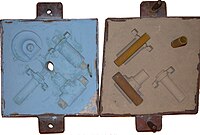
Photo from wikipedia
An experimental program was undertaken to study the mechanical behaviors of glass fiber-reinforced polymer (GFRP) tube confined recycled aggregate concrete with sea sand (GRACSS) under the axial compression. Two different… Click to show full abstract
An experimental program was undertaken to study the mechanical behaviors of glass fiber-reinforced polymer (GFRP) tube confined recycled aggregate concrete with sea sand (GRACSS) under the axial compression. Two different parameters were mainly considered: recycled coarse aggregates (RCA) replacement percentage (0, 100%) and type of sand (sea sand, river sand). Typical influences of RCA and sea sand on the strength, the deformation and the load–deformation curve of GRACSS were investigated. The test results showed that the failure pattern of GRACSS was similar to that of GFRP tube confined ordinary concrete (GCOC). The strength of GRACSS decreased with an increasing RCA replacement percentage, while sea sand could reduce the negative effect of RCA. It is also found that the peak deformation of GRACSS increased with the increasing RCA replacement percentage whereas with decreasing sea sand chloride ion (Cl–) content. The stiffness of the specimen was obviously influenced by the concrete type. Research findings indicated that the axial load-deformation curve of GRACSS can be divided into elastic-plastic and hardening stages. An analytical expression was proposed to calculate the load-deformation curve of GRACSS. Finally, the finite element method (FEM) was applied to study the effects of outer tube thickness, concrete strength, RCA replacement percentage and Cl– content in sea sand on the mechanical behaviors (strength and deformation) of GRACSS.
Journal Title: Advances in Structural Engineering
Year Published: 2020
Link to full text (if available)
Share on Social Media: Sign Up to like & get
recommendations!